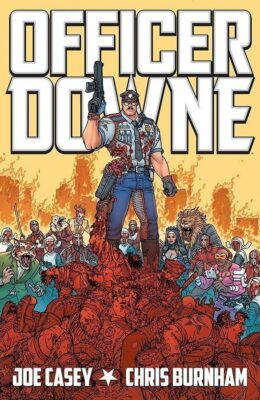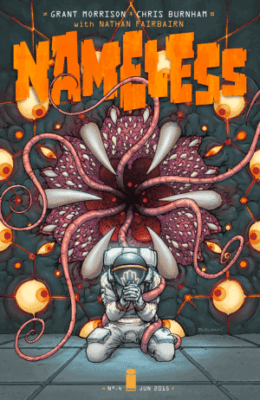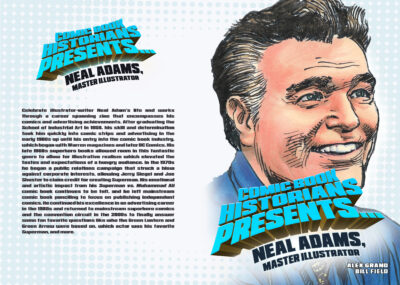Chris Burnham Interview, Comic Artist by Alex Grand & Bill Field
Check out Alex Grand & Bill Field’s biographical zine on Neal Adams in Comic Book Historians presents… Neal Adams, Master Illustrator!
meanwhile enjoy the show…
Bill Field: I’m here talking to one of my favorite DC artists, the wonderful Chris Burnham. You probably know his work from Batman Incorporated among other things and Chris, how are you doing?
Chris: I’m doing great. Having a good time so far.
Bill: Fantastic. For the folks at home, I was wondering if you could possibly give a quick rundown of your history as a comic artist.
Chris: All right Geez. I started out doing work for Moonstone actually. They’re a small horror publisher in Chicago. I did a couple issues of Moonstone monsters and a Kolchak the Night Stalker comic and then a little graphic novel called Boston Blackie inside out. That’s got to be 15 years ago or something. Then I started working at Image. I did a couple issues of Elephant Men, a graphic novel with Joe Casey called Nixon’s pals which is about a parole officer for super villains and it’s awesome.
Chris: You can buy it on Amazon right now. Go get it, it’s rad. Then we did a book called Officer Down, which was a small critical hit that started getting me work at DC.

I did a Batman Incorporated with Grant Morrison for three years, and then we did a book at Image called Nameless which is a super weird, super gross sci-fi horror comic. You should get that too. Now, Robert Kirkman and I are working on a book called Die, Die, Die. The first issue just came out last week. It is very funny, very violent. It’s kind of a Quentin Tarantino movie without the feet. It’s awesome.
Bill: Fantastic, and so who are your go to’s for the people that you looked up to and maybe inspired you to become an artist?
Chris: Growing up John Buscema was my shining light. How to draw comics the Marvel way is I still think the best book on how to draw comics at all.
When I got a little bit older Jack Kirby became a favorite of mine. Walt Simonson, Erik Larsen. The Fist of the North Star guy was a big influence on me for panel to panel action. I got my hands on a fair amount of un-translated Japanese editions of Fist of the North Star, Hokuto no Ken, and so being able to just look at that stuff with … I couldn’t read it if I tried.
Chris: Just being able to follow the panel to panel action. I really learned a lot about visual storytelling from doing that. There’s a million guys, Moebius and Frank Riley and Jeff Darrow, those are probably the more obvious surface level influences on my style at this point. There’s something to learn and copy from just about everyone.
Bill: Of course. Now, what I’m curious about is, what are some of your Con moments with some of these influencers? Now that you’re a pro yourself, have you met any of these people and what were your expectations and how’d you feel about meeting them?
Chris: Most of them were pretty nice. Frank Riley is a very nice guy. He was just randomly walking down the aisle and I said, “Hey, I’m Chris Burnham. I’m sorry for ripping off your style,” and he was like, “Oh, it’s fine. I’m ripping off Moebius and Darrow. It’s all the same thing.” I was like, “Okay, that’s good. That’s good that you’re not annoyed.” Yeah, most people are nice. I’m a bit of a, I don’t know what the word is. I’m a little socially awkward like most artists are so I’ve found a couple of real awkward bad run-ins with some guys. Jeff Darrow and I are always getting in dumb little fights and then making up. We’ll grate on each other and then make up again the next year. That’s happened a couple of times over the last 10 years. We’re in a friendly phase right now which is nice.
Bill: Except for the project you already mentioned, what’s on your horizon? Where do you want to go with your talents? What do you want to do in the future?
Chris: Oh, man. I don’t know. I think just more of the same at this point. Whatever the next fun idea is. We’re rolling on die, die, die for a while. It’s pretty fun. Lots and lots of goods and nonsense to draw. Fun action and character bits. Lots of subplots which I like. For the moment I’m having a great time with this. Who knows?
Chris: I don’t have any big … it’s not like I’m dying to draw the Fantastic Four or anything. I don’t have a big dream project other than whatever idle fancy strikes me next. For the moment die, die, die is awesome and I’m focused on that.
Bill: Working with guys like Grant Morrison and Robert Kirkman, do they bring you pretty detailed scripts and then when you visualize them … tell us a little bit about that process.

Chris: Most of the time they’re not too, too detailed. They trust the artist to execute on our own personal style. Unless it’s a very specific little bit of business, for the most part the descriptions are fairly bare bones. I would say that the main difference between their two styles is at the beginning of each issue and then maybe at the beginning of a particular set piece, Grant will take a page to say, “Here’s what we’re going for thematically. Here’s the weird movies and novels and comics’, comics’, Jesus. That we’re referencing. Here’s what to pull from for this sequence.”
Chris: With Kirkman it’s just, “Here’s the description just draw it.” They’re going for different things. Grant’s got greater thematic concerns at play when I think Kirkman, we’re just trying to tell a fun, quick, violent story. But as far as like panel to panel for the most part, they just say what happens in it and then I draw it.
Bill: Chris Burnham, we want to thank you for taking time out of your busy schedule here at the Con, because it’s nuts here. I just have to say artist alley is really on fire and so are you Chris Burnham. Thanks so much for being on the Comic Book Historian podcast.
Chris: Hey, my pleasure. Thanks a lot guys.
Join us for more discussion at our Facebook group
check out our CBH documentary videos on our CBH Youtube Channel
get some historic comic book shirts, pillows, etc at CBH Merchandise
check out our CBH Podcast available on Apple Podcasts, Google PlayerFM and Stitcher.
Images ©Their Respective Copyright Holders
Use of images are not intended to infringe on copyright, but merely used for academic purpose.
Interview © 2021 Comic Book Historians











